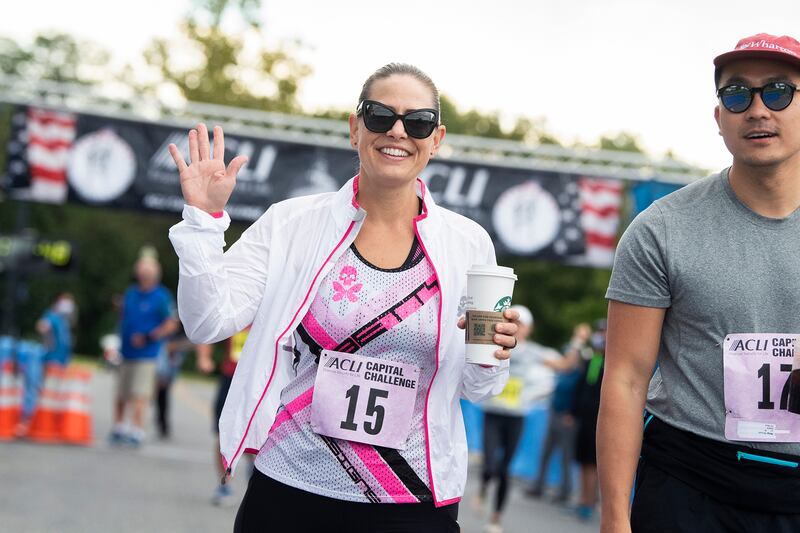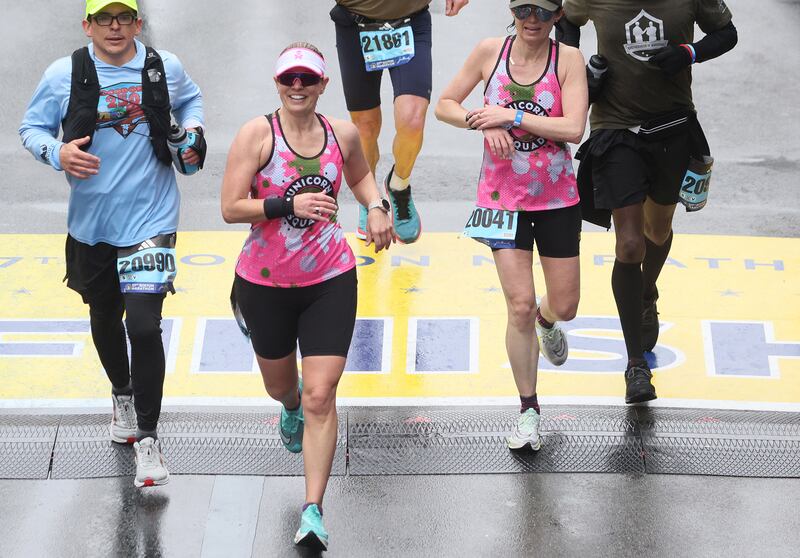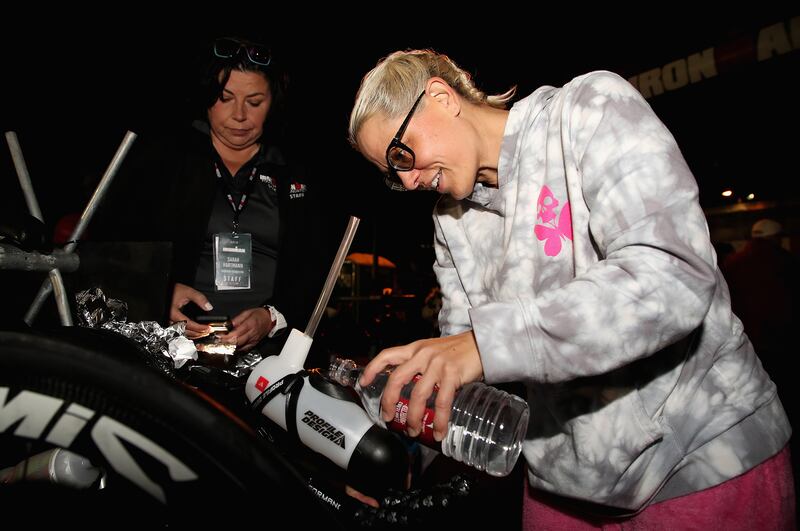When Kyrsten Sinema ran the Boston Marathon last year, it was a proud moment the Arizona senator—an avid marathoner and triathlete—wanted to publicize.
“It’s been a long road to get here,” Sinema tweeted, along with photos of her running and celebrating the finish. “I kept running qualifying marathons, but the pandemic and then a broken foot had other plans for me. Couldn’t be more grateful to have 2 strong feet and 1 happy heart this Boston Marathon!”
Far less publicized, however, was another aspect to Sinema’s long-awaited journey to Boston: She appears to have turned it into a fundraising junket, allowing her campaign to cover the thousands of dollars in expenses she would have incurred herself by traveling to the race.
According to Federal Election Commission records, Sinema collected over $16,000 in campaign contributions from a handful of Massachusetts-based donors in April 2022—many of them at the maximum level, suggesting she held some type of fundraiser, if a small one.
There’s further evidence in filings from Sinema’s personal political action committee, Getting Stuff Done PAC, which spent over $1,500 on “meeting meals” and “event supplies” at Boston-area businesses the week of the race.
As it happens, in April 2022, Sinema’s campaign paid $8,470 in lodging expenses at an unspecified Ritz-Carlton Hotel. The photo Sinema posted to Twitter, however, showed herself and a friend posing in a hotel room with celebratory gift bags and certificates—which bore the luxe chain’s distinct lion logo.

The Boston trip was far from the first time that Sinema has appeared to fuse a donor get-together onto a personal racing trip allowing her to write off travel costs.
On at least six total occasions since 2019, Sinema has participated in a race while engaging in fundraising activity—and covering expenses—in the area of the competition, according to a review of public campaign finance and competition records.
In May 2019, for instance, Sinema ran in the Mountains2Beach Marathon in Ventura County, California. In a two-week period around the race, Sinema raised some $21,000 from southern California-based PACs and donors, all giving hundreds or thousands of dollars; in the same time period, her campaign reported spending $400 to a Santa Barbara-based vendor for “lodging.”
In June 2021, Sinema participated in the Light at The End of the Tunnel Marathon outside Seattle. That same month, she raised over $18,000 from a small group of Washington state-based donors.
In October 2021, Sinema attended the Boston Marathon, but did not compete due to her broken foot. Still, her PAC reported spending nearly $1,500 on catering expenses to a Boston-based chain of high-end restaurants the same week, while her campaign spent over $5,200 to Black Tie Limo, a Boston-based transportation company. That month, Sinema raised some $36,000 from big-money Massachusetts donors.
Under FEC rules, candidates cannot use campaign funds to “fulfill any commitment, obligation, or expense of a person that would exist irrespective” of their running for or holding public office.
A spokesperson for Sinema did not respond to a detailed list of questions about her spending surrounding marathons and other athletic competitions.
According to campaign finance experts, Sinema may be following the letter of that rule, but is pushing into a gray area by appearing to tie legitimate campaign activity to unrelated personal pursuits.

Sen. Kyrsten Sinema, walks the ACLI Capital Challenge 3 Mile Team Race in Anacostia Park on Sept. 29, 2021
Tom Williams“Tacking some personal activities on to a fundraising trip is generally going to be fine,” said Brendan Fischer, deputy executive director of the watchdog group Documented. “But this appears to be the inverse—tacking fundraisers on to personal trips to justify the use of campaign funds to cover the costs.”
That athletes typically train and plan for big races, like Boston, months or even years in advance makes it highly unlikely that Sinema’s fundraising activity was scheduled as the priority, said Fischer.
“The FEC generally isn’t going to scrutinize this kind of spending,” he said. “But at the same time, I doubt any FEC commissioners would declare that a candidate may travel anywhere they want using donor funds, as long as they ask another donor for more money while there.”
Saurav Ghosh, an attorney with the nonpartisan Campaign Legal Center, agreed. “In a world where officeholders are really scrupulous about not only following rules to the letter but to the spirit, she wouldn’t be using campaign funds to pay for these things,” he said.
As Sinema gears up for a potential 2024 re-election bid, the independent senator is facing increasing scrutiny, not only for her considerable policy influence but how that influence has spurred big money donors and interests to support her campaign.
In a divided Senate, Sinema has leveraged her clout to secure wins for, among other moneyed interests, Wall Street and the crypto industry. Those two industries in particular have responded by pouring cash into her campaign and personal PAC. In the first three months of 2023, Sinema raised $2.1 million—much of it maximum contributions from individuals and PACs—giving her a $9 million campaign warchest heading into a potential 2024 showdown. (She has not yet officially announced her plans.)
Recently, Sinema’s questionably lavish campaign spending has drawn attention in outlets like the New York Post, which noted the eye-popping cash the oenophile senator has dropped on fine wines. In February, The Daily Beast reported on the unusually high amount that Sinema paid for security—and to a single contractor, her friend Tulsi Gabbard’s sister, Vrindivan Bellord.
Taken together, such data points demonstrate a troubling pattern to observers like Fischer.
“It is one thing to ask donors for money to support your campaign and get your message out to voters, it is another to ask them to bankroll your personal life,” he said. “If an officeholder is using donor dollars to subsidize their lifestyle or finance personal expenses, then campaign contributions pose a much greater risk of corruption.”
For Sinema, few pursuits define her lifestyle more than competing in triathlons and marathons. Her deep commitment to training and traveling for races extends well into her duties as a senator—sometimes even overriding them.
In March 2019, for instance, Sinema missed a week of legislative business while participating in a triathlon in New Zealand. She was absent for several high-profile votes on Trump administration nominees, including Environmental Protection Agency Administrator David Wheeler.
An internal guide to staffing Sinema, first reported by The Daily Beast last year, laid out in detail how much of her time was devoted to athletic pursuits—and how much her staff worked to square her regimen with the duties of public service. “These activities are very important to her and should be protected,” it reads.
Among other things, aides were expected to put her races on her calendar, ensure she had adequate rest time before race days, book recovery massages and physical therapy sessions for her during Senate workdays, and find hotels for her that had regulation-sized pools for lap swimming.
It’s impossible to exactly quantify how much campaign cash Sinema may have devoted to trips that included races, largely because candidates aren’t required to disclose much detail around airfare, hotel, and rental car expenses. At least $18,000 worth of expenses covered by Sinema’s campaign and personal PAC are easily tied to trips in which she also competed in a race.
Judging by Sinema’s astronomical outlays for travel in general, however, it’s likely the number is far higher.

Sen. Kyrsten Sinema, second from left, crosses the finish line of the 127th Boston Marathon.
Jessica Rinaldi/The Boston Globe via Getty ImagesIn a four-year span from 2019 to 2022, during which Sinema was not on any ballot, her campaign spent over $117,000 on airfare expenses. Compared to her colleagues, she’s a clear anomaly. Two fellow western state Democrats, also facing competitive elections in 2024, spent fractions of that amount in the same time period: Sen. Jon Tester (D-MT) spent $18,300, while Sen. Jacky Rosen (D-NV) spent $23,600.
The differences are just as stark when it comes to lodging expenses. In the same time period, Sinema spent over $105,000 on hotels, while Tester and Rosen each spent about $9,300. Notably, some of Sinema’s travel spending is earmarked as “security detail” expenses, bringing up her costs.
According to Ghosh, those discrepancies fuel a pattern of campaign spending by Sinema that he described as “maybe lawful, but certainly seems inappropriate.”
“Any time you see someone spend four, five, six times in a category from one of their comparables, it definitely raises a question of whether that’s a legitimate use of campaign funds—and certainly, even if it is legitimate, whether it is appropriate,” Ghosh said.
“That’s generally indicative of somebody who has figured out the system, knows where the cracks are, and is using this one to have the campaign finance a lot of things,” he added.

Sen. Kyrsten Sinema prepares to race in the 2019 Dignity Health Medical Group IRONMAN Arizona on Nov. 24, 2019 in Tempe, Arizona.
Christian Petersen/Getty ImagesAmong Sinema’s racing-slash-fundraising trips, one stands out as an anomaly—in that she didn’t raise any money.
On Aug. 3, 2019, Sinema participated in an Ironman race in Boulder, Colorado. Roughly two weeks later, Sinema’s campaign paid a Denver-area vendor $765 for “event catering.” In the three months prior to the trip, her campaign spent nearly $7,000 on airfare.
But Sinema raised no money in Colorado in Aug. 2019, aside from three small-dollar contributions processed online.
The locations for some Sinema fundraisers raised eyebrows among observers, even when it was not clear she was also going to those places to compete. When they travel to fundraise, Democratic politicians—of which Sinema was one until last year—typically prioritize hitting wealthy liberal hotspots in New York, Los Angeles, and the San Francisco Bay Area.
Sinema, however, is a rare Democratic politician to have tapped deep-red Utah for campaign donations.
In the final week of September 2022, Sinema reported raising some $24,400 from 10 big-money donors in Utah. On Sept. 24, Sinema participated in the Belgian Waffle Ride—a series of long-distance off road bicycle races—in Cedar City, Utah. Four days later, her campaign reported spending $223 at a pizzeria in the same southern Utah town for a “meeting meal.”
Weeks before, Sinema had already traveled to Utah for a different fundraiser and race; they were likely too far apart to be linked. Still, in its report on Sinema’s donor confab in Salt Lake City—geared to finance and banking executives—the Salt Lake Tribune noted the strange optics.
“Republican-dominated Utah may seem like an odd choice for Sinema to prospect for campaign donations,” the article read. (In addition to enjoying athletic events in Utah, however, Sinema is close with the state’s junior senator, Mitt Romney, and was raised in the Mormon church that dominates the state.)
As Sinema steps up her fundraising ahead of a likely re-election bid, Ghosh said Sinema should be expected to answer to donors and to the public about her use of campaign funds.
“It’s almost certainly not unlawful,” he said. “At the same time, her potential donors and her constituents really have a right to see how she is choosing to spend her money. I think it’s a legitimate question: should you be having an event that’s clearly happening where it’s happening because of the race, and getting the campaign to foot the bill for travel and lodging?”







